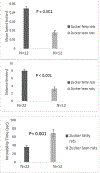Reversal of Early Increased Anxiety-Like Behavior in the Zucker Fatty versus Lean Rat: Possible Role of Acquired Hormonal Factors
- PMID: 37671406
- PMCID: PMC10478757
- DOI: 10.31038/edmj.2023724
Reversal of Early Increased Anxiety-Like Behavior in the Zucker Fatty versus Lean Rat: Possible Role of Acquired Hormonal Factors
Figures









References
-
- Kurtz TW, Morris RC, Pershadsingh HA (1989) The Zucker fatty rat as a genetic model of obesity and hypertension. Hypertension 3: 896–901. - PubMed
Grants and funding
LinkOut - more resources
Full Text Sources
